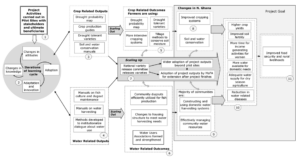Purpose: design and monitor which interventions are relevant to achieve a given (social) change
Who is it for: projectmanagers
Technique: workshops
Type of tool: implementation tool
Prior knowledge: substantieel
Complexity: high
Time investment: days/weeks
Downloads
Links
Related tools
What is PIPA?
Multidisciplinary research projects and programmes play an important role in addressing societal challenges. However, traditional evaluation methods with a focus on accountability and measuring the excellence of scientific outputs are only limited in their ability to map the impacts of these complex multidisciplinary research collaborations.
Participatory Impact Pathways Analysis (PIPA) is a method that addresses this and is designed for the participatory planning and evaluation of projects and programmes. PIPA integrates the principles of participatory approaches with analysis of impact pathways, creating a structured and shared framework that allows stakeholders to collectively identify, assess, and monitor the intended and unintended outcomes of an intervention.
At its core, PIPA serves as a method to unravel the complex dynamics of projects, allowing stakeholders to arrive at a shared understanding of the causal relationships between inputs, activities, outputs, results, and impact. This tool is particularly valuable in sectors and issues where understanding the interactions between different actors is crucial for project success.
How do you use PIPA?
PIPA takes place in several stages, in which a workshop with stakeholders is the central element. The figure below summarizes the outline of the PIPA process. Below the figure, we explain these steps in more detail.

Preparation
Identifying and connecting with stakeholders is the foundation of a successful participatory approach. Start by conducting a stakeholder analysis to identify the relevant parties. This includes local communities, government agencies, non-governmental organizations, companies and other stakeholders. The goal is to involve a broad, diverse group of participants who represent different perspectives, and are required to achieve the intended impacts in your research project.
The core of the PIPA is the participatory workshop with the aim of involving the various stakeholders in the development of your research project. Prior to the workshop, the project leader, in collaboration with another person involved in the core team, will set up a preliminary problem tree. A problem tree provides a visual and systematic overview of the underlying causes of the societal problem that the project is intended to address. This problem tree is then shared with the participants before the workshop so that they can have a look at this tree in their preparation and can already think about any comments, changes, and additions to the problem tree.
Workshop
In the workshop, the attendees are divided into two or more groups. Attention should be paid to a good distribution of people over the groups. Then, in the first part of the workshop, the following steps are followed:
- Elaboration of the final problem tree: each group reflects on the preliminary problem tree in order to develop a new problem tree on a poster, to present and discuss it in plenary.
- Convert problem Trees to Goal Tree: Each group rephrases the problem tree to a goal tree by describing the situation in which the problem was solved. For example, ‘food insecurity’ becomes ‘food security’. In this way, it becomes clear which outputs a project needs to realize in order to contribute to the solution of the problem.
- Visualize project success: Each group discusses what project success would look like. This can be done, for example, by asking the following question: “Two years after the end of your project, you wake up. Your project has been a success and is well on its way to achieving its goal. Describe what this success looks like:
-
- What’s happening differently now?
- Who does what else?
- What are the changes in the lives of the people who use the project outputs?
- How are project results scaled up?
- Drawing up a timeline of key moments and activities: each group uses a timeline to provide insight into which activities and key moments there are in realizing the outputs and vision.
After a break the participants will plenary work on:
- Creation of network maps: in this step, participants will work on creating a current and future network map (see image below):
- Current network map: building on the goal tree, the participants map out the actors and relationships that are currently needed to realize the outputs.
- Future network map: building on the vision of project success, participants map out the actors and relationships that will be needed in the future to achieve success.
- Drawing up a network action plan: a comparison between the current and future network provides insight into which relationships are still missing to achieve project success. Since relationships do not arise on their own, a plan is drawn up to involve missing actors and relations in the project.
After completion of the workshop
After the workshop, the project leader integrates the objective tree, the project deliverables, the vision and the timeline into an impact path model of the project. Specific attention is paid to how success can also be scaled up further. Subsequently, if necessary, the network maps can be further elaborated and an impact narrative can be drawn up that describes how the intervention will lead to an effect on the basis of the impact path model. On the basis of the impact pathway model (see image below for example), indicators can also be developed in subsequent steps, with the emphasis on mapping the extent to which the impact pathways function as assumed.

What is the origin of PIPA?
The PIPA tool is described in Douthwaite et al. (2007) who developed it as part of the research for development program “Challenge Program on Water and Food”. It built on traditional analysis of impact pathways, integrating participatory methodologies to improve the relevance and sustainability of development interventions. To this end, PIPA draws on insights from the field of development studies, systems thinking and participatory action research. Since 2007, several variants of this model have been developed and applied, with the aim of addressing the specific needs of stakeholders and practical considerations such as their time availability to participate in the workshop. Van Droog and Spaapen (2022) describe their experiences with applying PIPA in the Dutch context.





